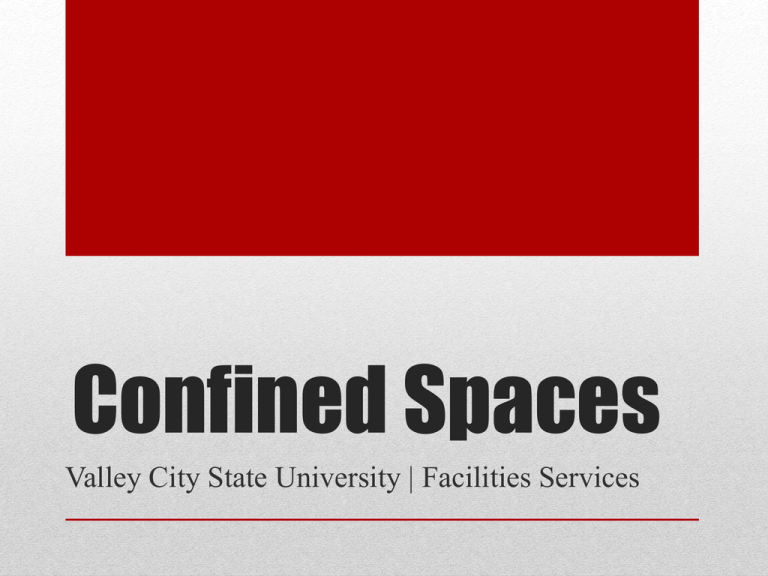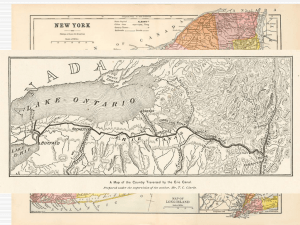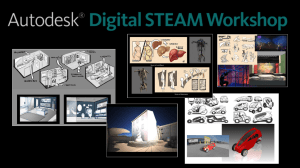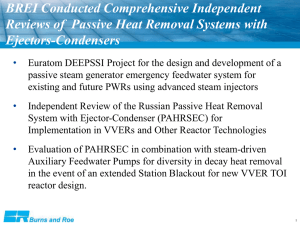Lockout/Tag-out Procedures - Valley City State University
advertisement

Confined Spaces Valley City State University | Facilities Services • Some VCSU employees are required to perform work duties in areas restricted of size, limited entry/exit room and other less than ideal conditions. Working in confined spaces can be a major safety hazard if the employee is not educated on the safety procedures of this working condition. • Facilities Services Supervisors and other related supervisors should educate their employees of these safe operating procedures. Introduction • What is a CONFINED SPACE? • Areas on campus with these limitations: • Large enough for and employee to bodily enter and perform the necessary work. • Has restricted means for entry/exit- includes the following areas: • Tanks, vessels, steam tunnels, hoppers, storage bins, vaults, silos and pits. • Are not intended for extended employee occupancy. • There are also confined spaces that may contain hazardous air quality or other similar characteristics. These spaces should be treated with caution and Personal Protective Equipment (PPE) may be required. Definition NON-PERMIT CONFINED SPACE • A confined space NOT containing ANY of the characteristics listed under permit-required confined spaces may be considered a non-permit confined space. • Steam Tunnels/Vaults/Man Holes • A confined space that contains any other recognized serious safety or health hazard, including areas or processes that must be locked out or tagged out per the Valley City State University Lockout/Tag-out Program. • Boiler Definition (cont.) • Employees who are to work in confined spaces should be trained on the following: • Procedures in the use and maintenance of the monitoring equipment. • Use and application of respiratory equipment. • Use and application of ventilation systems, fans or blowers. • Use and application of fall protection. • Lockout/Tag out procedures. Training • The steam tunnel/vault system is a controlled access work area. Only authorized personnel are allowed to enter the steam tunnel system. • The main tunnel system is designed for employees to enter through building equipment room doors, walk through the tunnel passes, and perform equipment maintenance. • Certain sections are only accessible through manholes. • There is one entrance/exit point in all steam manholes with a ventilation point. Procedures- Steam Tunnel/Vault • Only steam travels through the tunnels/vaults/manholes making the possibility for a hazardous atmosphere remote. • As defined by OSHA, the following hazards DO NOT exist in VCSU steam tunnels/vaults/manholes: • Entrapment Hazards (Means of egress are restricted or limited, but not impossible) • Engulfment Hazards • Exposed energized electrical conductors, moving machinery or lines that discharge hazardous materials Procedures- Steam Tunnel/Vault • The most serious hazard is the potential for a steam line rupture. • This hazard can be significantly reduced through preventative maintenance. • Use of an attendant, retrieval equipment, and air monitoring devices are not practical and do not protect employees (may actually hinder self-rescue) from the most significant potential hazard, a steam line rupture. • Use the “buddy system” is a requirement when actively working on energized steam lines. Procedures- Steam Tunnel/Vault • Steam Tunnel Entry Procedure • Each employee shall notify their Supervisor(s) prior to entering the steam tunnels. The Supervisor shall verify that the employee has received the proper training to enter the steam tunnels. The Supervisor will assess the required employee training on a periodic basis. • Prior to entering the steam tunnels, the Supervisor and employee will discuss the scope and sequence of work. • Assess all potential hazards • Locations of energized steam lines, compresses air-lines, electrical conductors • Locations of exposed hot surfaces • Signs and symptoms of heat exhaustion and heat stroke • Hazards created by work activity and external hazards • Means to control hazards Procedures- Steam Tunnel/Vault • Steam Tunnel Entry Procedure (cont.) • Identified the locations of entry and egress from potentially dangerous work conditions. • The “buddy system” will be used by employees when actively working on energized system or when the employee has a preference because of safety reasons. • Employees working in the tunnel will carry a flashlight, carry a cell phone, wear protective gloves or other types of Personal Protective Equipment. • Set up a fan at one end of the tunnel to provide better ventilation in the area. • When working in steam man holes, make sure that both doors are open. Procedures- Steam Tunnel/Vault • Boiler Entry Procedure • Boilers must be shut down several days prior to cleaning to allow cooling. Fireboxes of water-tube boilers should be cooled to essentially ambient temperature prior to entry. • They must be left open to the room with the draft open to assure adequate ventilation before entry. • Lockout/Tag-out • Electrical load centers to all motor-driven auxiliary equipment (including fuel pumps and flame failure devices) should be de-energized and locked out. Where fuses are provided and accessible they must be removed while the boiler is out of service. • Valves and/or piping to interconnected systems (such as steam, blow-off, and feed water) should be fully closed and locked, and common piping connections (with no stop valves) should be blanked off. • The safety procedures must specify who is responsible for each phase of the isolation of the boiler and its return to service. Where more than one person is involved, the person with prior authority must determine that all safety measures are in effect before allowing anyone to enter a boiler. • Someone must be designated and trained to stand at the entry to monitor and assist those working in the confined space. Procedures- Boiler • Valley City State University will rely on rescue personnel from the Valley City Fire Department, Valley City Police Department and Valley City Ambulance Service in the event of an emergency during a confined space entry. • These emergency services are accessible by dialing 911 from any campus telephone. Emergency Response & Rescue THIS CONCLUDES THIS PORTION OF THE TRAINING… Take a 5 minute stretch break before we continue to the next module.








